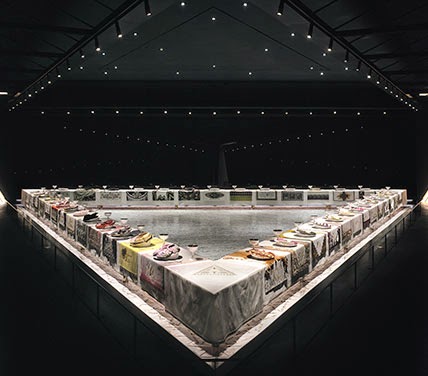As I ponder the meaning, depth,
and fluidity of culturally relevant
pedagogy, I cannot help but think of (current) trends in education, trends
that almost completely remove the student as the axis of learning and seek to
educate a homogenous group of children. Trends that “[add] some books about
people of color, [have] a classroom Kwanzaa celebration, or [post] ‘diverse’
images [to make] one ‘culturally relevant’” (Ladson-Billings, 82). The
“voyeuristic culture-vultures that consider [insert form of pop culture] to be
the next trendy thing that can be used to hook students, only to draw them back
into the same old hegemonic, hierarchical structures” (Ladson-Billings 82).
In
her introduction to TDPC, Judy Chicago discusses her reaction to an
interpretation of The Dinner Party. “Although
I knew the teacher had not intended to offend, this interpretation of The Dinner Party deeply disturbed me.
While there is nothing wrong with doing autobiographies on plates, it is a
mistake to claim that such a project has anything to do with The Dinner Party, which is about women’s
achievements in history” (Chicago, from Introduction to TDPC). Chicago’s statement addressing an
instance in which her work was utilized for educational purposes but completely
out of context echoes Ladson-Billings concerns over the meaning of “culturally
relevant pedagogy” once it was introduced to “the marketplace of ideas”:
misuse, misinterpretation and, even, a “distortion and corruption of the
central ideas” (Ladson-Billings 2014, p. 82).
As educators, some of our best intentions
can be misguided and overlook the value found in the diversity of our students.
Sometimes we just miss the point. One
of the central ideas of culturally relevant pedagogy is viewing “students as
subjects rather than objects” (Ladson-Billings, 77). By repositioning the students as subject, they can be valued
as “sources and resources of knowledge” (Ladson-Billings, 79) rather than mere
recipients. This idea pushes students to engage with material that challenges
their personal experiences and pre-conceived notions. By drawing from their own
personal experiences, students make meaning that is relevant and valuable to
them. In the study guide for Killing Us
Softly 4, students are asked to use dialogue, collaborative projects, and journals to “think critically and independently about
this material from a number of different perspectives, and to develop and
defend their own point of view on the issues at stake.” Culturally relevant (sustaining) pedagogy also challenges the way
we as educators view our students. Are we among those trying to fit our
students into a formula? Do we have pre-conceived notions of our own? Or are we exploring the individuality of our
students, meeting them where they are and appreciating them for what they bring to the table?
Resources:
Ladson-Billings, Gloria (2014). Culturally Relevant Pedagogy 2.0: a.k.a. the Remix. Harvard Educational Review, 84(1), 74-84.

No comments:
Post a Comment